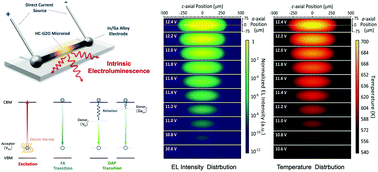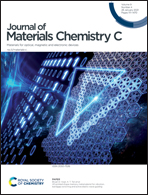Current-induced thermal tunneling electroluminescence via multiple donor–acceptor-pair recombination†
Abstract
The roll-off of quantum yield is a major challenge facing light-emitting diodes due to the inevitable predominant non-radiative recombination with temperature elevation. Here we report highly-efficient intrinsic electroluminescence (EL) from a biased highly-compensated ZnO:Ga (HC-GZO) microrod with a metal–semiconductor–metal (MSM) structure at high temperatures. The origin of the EL emission is the current-induced Joule heating activation of electric-thermal tunneling electrons and the following spontaneous radiation from multiple donor–acceptor-pair (DAP) recombination. The reduced oxygen vacancy (VO) concentration via Ga doping promotes the electron–phonon coupling to lower the temperature threshold down to ∼650 K, facilitating the stability and durability of MSM-EL devices. Meanwhile, an extra channel of radiative recombination is established by introducing Ga donor dopants, expanding the luminescence color space from orange (0.496, 0.445) to red (0.529, 0.408) by varying the VO concentration in HC-GZO microrods. The present work motivates research on the mechanism and architectural design for novel electric-thermal tunneling induced efficient radiative emission devices at high temperatures using bandgap-engineered semiconductors.



 Please wait while we load your content...
Please wait while we load your content...